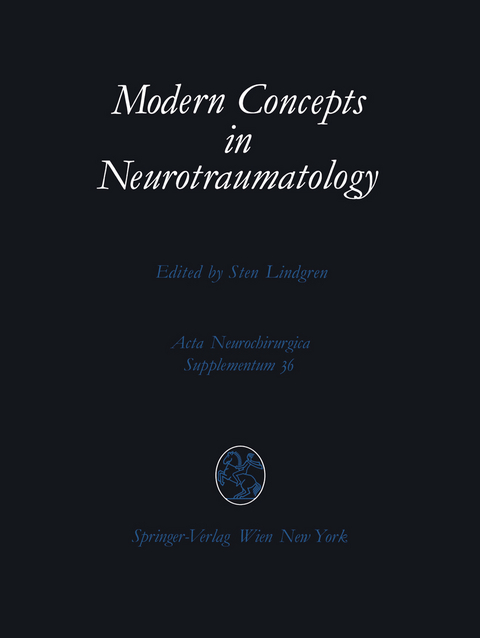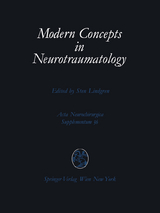Modern Concepts in Neurotraumatology
Springer Wien (Verlag)
978-3-211-81931-9 (ISBN)
Epidemiology.- Epidemiology of Accidents in the Field of Traffic Medicine.- Epidemiology of Head Injuries in Sweden.- Head Injuries in a Population Study.- Acute Injury Statistics-a True Picture?.- Biomechanics; Injury Scaling; Neuropathology.- HIC-the Head Injury Criterion.- Injury Scaling.- Time-Related Severity Scaling of Head Injuries-Discussion on the AIS-Severity Code-Early and Late.- Acute Injury Scaling Related to Residual Disability.- Biomechanics-Material Properties and "Tissue Damage".- Head Injuries-Biomechanical Principles.- Experimental Models of Head Injury.- Head and Neck Injuries.- Aspects on Pathology and Neuropathology in Head Injury.- Care in the Acute Phase of Head Injuries.- Care at Accident Site and During Transport.- Guidelines for Care in the Acute Phase in Hospitals Without Neurosurgical Specialists.- Resources for Head Injury Patients at Different Hospital Levels.- Resources for Mild, Moderate and Severe Head Injury Patients.- Resources, Distribution and Management Levels of Head Injury Patients; Place of CT-Scanning.- Diagnostic Terminology of Head Injuries.- Is Diagnostic Severity Grading for Head Injuries Possible?.- Diagnostic Terminology of Head Injuries-Related to Severity.- Evaluation of Impairment of Consciousness.- Experimental Animal Physiology Related to Brain Stem Control of Wakefulness.- Awareness, Wakefulness and Arousal.- Electrophysiological Assessment of Conscious Level.- Clinical Assessment of Consciousness.- Assessment of Responsiveness in Head Injury Patients.- Practical Assessment of Patients with Head Injuries.- Acute Head Injury-Management Charts.- Is it Possible to Define a General "Conscious Level"?.- Factors Restricting the Use of Coma Scales.- Outcome.- Prognosis and Prediction of Outcome inComatose Head Injured Patients.- Dizziness and Vertigo in the Posttraumatic Syndrome.- Possible Mechanisms of "Vegetative State".- Abnormalities of Sympathetic Regulation After Cervical Cord Lesions.- Pathophysiology and Pathomorphology.- Molecular Mechanisms for Ischemic Brain Damage and Aspects on Protection.- Structural Aspects of Ischemic Brain Damage.- CBF in Head Injury.- Brain Edema.- Treatment and Prognosis.- Possible Evaluation of Treatment and Prognosis in Brain Contusions by Means of the Isoenzyme Creatine Kinase (CK-BB) in the Blood.- Posttraumatic Monitoring of Intracranial Pressure.- Prognosis as the Basis for Selection to Treatment After Severe Head Injury.- Comments on Nonoperative Treatment of Severe Brain Injuries.- Craniofacial Surgery for Trauma.- Traumatic Intracranial Hematomas: Pathophysiological Aspects on Their Course and Treatment.- Head Injuries in Children-Special Features.- General Literature.
| Erscheint lt. Verlag | 10.11.1986 |
|---|---|
| Reihe/Serie | Acta Neurochirurgica Supplement |
| Zusatzinfo | VIII, 158 p. |
| Verlagsort | Vienna |
| Sprache | englisch |
| Maße | 210 x 279 mm |
| Gewicht | 560 g |
| Themenwelt | Medizinische Fachgebiete ► Chirurgie ► Neurochirurgie |
| Medizin / Pharmazie ► Medizinische Fachgebiete ► Intensivmedizin | |
| Schlagworte | Biomechanics • brain • Care • epidemiology • Head • Head Injury • Neuropathology • pathophysiology • Surgery • Trauma • trauma surgery • traumatology |
| ISBN-10 | 3-211-81931-2 / 3211819312 |
| ISBN-13 | 978-3-211-81931-9 / 9783211819319 |
| Zustand | Neuware |
| Informationen gemäß Produktsicherheitsverordnung (GPSR) | |
| Haben Sie eine Frage zum Produkt? |
aus dem Bereich




